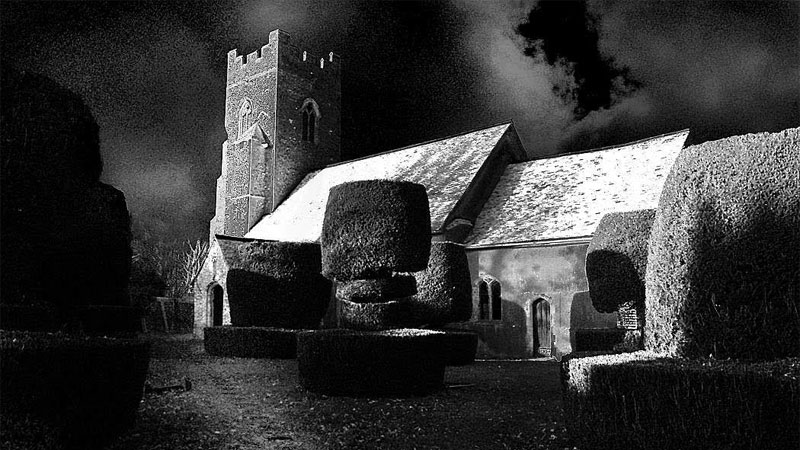EDDIE BRAZIL tells us why gothic landscapes and buildings are the perfect spooky setting for a spooky film, literature and art…
Have you ever wondered why it was that when Dracula rose from his midnight coffin he did so within the depths of a dark, dank, vaulted crypt?
Or when lightening life was given to Frankenstein’s monster it took place atop a crumbling medieval castle.
Or why most people would shun walking home after dark through a deserted graveyard, or why it was that the screenwriter of Hammer Film’s 1959 adaptation of Arthur Conan Doyle’s Hound of the Baskervilles chose to climax the movie not on a bleak expanse of fog shrouded moor, but rather within the crumbling ruins of an ancient abbey?
It is indeed a paradox. Churches, abbeys and places of worship. We all recognise a church as a place of peace, reflection and spiritual fulfilment. Yet, it is also where the dead are laid to rest. Where the iconography of death and sinners dragged to hell leer down from the walls at the living. And it is also a place, as Charles Dickens observed in his short story, ”The Chimes”, where not many people would care to sleep at night and alone.
“The night wind has a dismal trick of wandering around a building like that, and moaning as it goes. Trying with unseen hands, the windows and the doors by which to enter. And when it has got in it wails and howls stalking through the aisles and gliding round the pillars. And then passes, muttering in to the vaults, creeping along the walls seeming to read, in whispers, the inscriptions of the dead. It has an awful voice, the wind at midnight, singing in a church.”
Further ecclesiastical and ancient structure reference points are to be found in the supernatural fiction of writers such a M.R. James, Edgar Allan Poe, H.P. Lovecraft and W.F. Harvey. Authors such as these were in essence responding to a tradition which had emerged in the late 18th and 19th centuries. It was a movement that had at its source not irrefutable cast iron evidence of the paranormal, but rather a cultural, spiritual, romantic and, in some ways, social necessity, one which had its roots in one word – Gothic.
The Smug Classicists name Gothic
The word “Gothic” was original meant to be derogatory.
It was first coined in early 16th century by the Italian historian and writer, Giorgio Vassari. He looked upon the style of the Middle Ages as and unrefined and barbaric.
Linking it with the “Goths” who had overran Europe in the 5th century. At the time Vassari was writing, Italy had experienced a century of building in the classical architectural vocabulary revived in the Renaissance, and seen as the finite evidence of a new golden age of learning.
Four centuries before Vassari made his disparaging remarks, the architecture of Europe was Romanesque. However, in 1174, the introduction of the pointed arch revolutionised church building. It allowed for a greater emphasis on lightness and refinement. Walls became thinner, naves higher and window openings larger allowing for adornment with stained glass, with columns, capitals, and mouldings which were embellished with the skills of the medieval masons. The interiors were aglow with images of the saints and the diffused glimmer of candles which bathed the church in a soft sacred, mysterious radiance.
And yet, the Protestant Reformation which engulfed the continent following Martin Luther’s Wittenburg protest in 1517, was to have a profound impact on the Gothic style.
The Reformation in England coincided with new ideas of the Renaissance with its emphasis on classical study and art forms. The dissolution of the monasteries, and the establishment of Protestantism all pointed to a nation which was moving away from the medieval era. Gothic architecture only served to be a reminder and embodiment of the old superstitions.
The mystery and magic of a medieval church interior had been replaced with the, bare, box pews and blank walls of English Protestantism, where the sermon took precedent over the sacrament.
The supernatural had deserted the church, for worship which had once been something mystical to behold had become an intellectual process.
By the 18th century, the enlightenment swept across Europe. It advocated reason, with a strong belief in rationality and science. The architecture of the age of reason was neo classical with its clearness, elegance and emotional restraint which mirrored the ideas and beliefs of the rationalists.
However, just as Gothic had had its detractors so too would the smug advocates of classical rationalism.
The Romantics Response
The Romantic movement grew out of a revolt against the proscribed rules of classicism.
It was a desire to return to nature and the exhalations of the senses and emotions over understanding and intellect.
It rejected the theory that only reason alone, unaided by experience can arrive at basic truth regarding the world, emphasising emotions as horror, and fear and the feelings experience in confronting the sublimeness of untamed nature. The romantics repost was through music, art and literature.
The graveyard poetry of the early 1700s such as Robert Blair’s ”The Grave” (1743), and Edward Young’s ”Night Thoughts” (1749) dwelt upon the melancholy pleasures and fears of the tomb, of the night and of ghosts.
In 1764, Horace Walpole published ”The Castle of Otranto” considered the blueprint for what would come to be known as Gothic literature.
Many writers followed suit and produced novels complete with castle dungeons, ivy-clad ruins, moonlit graveyards, churches, abbeys and white-sheeted spectres.
It was a rejection of the intellectual arrogance of man and science which was so forcefully put by Mary Shelly in her novel ”Frankenstein”; a warning to man not to play God.
The ghosts and phantoms of the Romantic imagination could not flourish within the conformity and logic of the architecture of classical rationalism.
Their natural dwelling place was the style of the early 14th century – decorated Gothic, the spiritual home of not only the writers and artists of the romantic period, but also the preferred form of the revival within the Church of England which began in 1840 and which ran parallel with an interest in medievalism and as a reaction against the horrors of the industrial revolution.
To Augustus Pugin, the English-born architect and theorist, to be a romantic was to be gothic and the mystery of sublime and supernatural fulfilment could only be truly experienced among the soaring pinnacles, columns, spires and ruins of the architecture of the medievalists.
The Romantic Flame Still Flickers
Today, our perception of where ghosts and vampires dwell is still conditioned by the heroic stance of the romantics against the cheerless rationalists.
Sadly, the phantoms and spooks of the romantic era struggle to survive in an increasingly troubled and cynical world.
Today’s most frequently reported ghost is the noisy and violent poltergeist, which seems perfectly happy within the humdrum of an ordinary suburban semi.
Maybe they were made for one another.
The light of Romanticism, however, still continues to flicker amidst the debris of modern life as people continue to embrace the uncanny, unknown and the paranormal as an antidote to the contemporary craziness which affects us all.
Perhaps hoping that those things which still linger in Heaven and Earth will remain forever out of the grasp of miserable, sneering philosophers.



